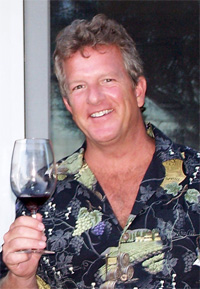Tags
BBQ, Chardonnay, Chicken, chocolate, Duck Confit, exotic, Gallo, pairing, pepper, Pinot Noir, red wine, sauvignon blanc, Sonoma, Sonoma County, St. Francis, St. Francis Winery and Vineyards, syrah, Trader Joe's, white wine, wine, wine pairing, Zinfandel
California wine historian Sandrew Montgomery is the go-to guy for an upbeat and diverse wine education or to host an unforgettable wine pairing event. Known in the Sonoma and Napa valleys as the one to deliver “the ultimate California wine experience,” Sandrew’s base is far from limited to New World wines, having begun his career as a professional taster in 1977 in Denver with French cuisine and wines. Since his early years, Montgomery has developed his pairing persona from wine educator to “original, personal sommelier,” launching cult wineries and creating a fun environment to learn about wine and food, whether you come with young taste buds or a seasoned global palate.
“You can never learn it all,” says Sandrew, admiring the deep color of a Petite Syrah at Sonoma Valley’s St. Francis Winery and Vineyards. He is both calm and passionate, with a smile that foreshadows the ease he puts you at, since “there is no such thing as a dumb question abut wine.”
Sandrew grew up in the South, where dinner table-bottles were bourbon, scotch, and vodka. At 15, he tasted his first wine, Gallo Hearty Burgundy.
“That was not my epiphany wine,” he says grinning.
Neither was the German Riesling he enjoyed in college, although he was growing more fond of wines and studied about the labels. A Spanish friend introduced him to Rioja, his first favorite of European terroir. The next several years working in French cuisine were an indelible influence in his understanding and appreciation for the varietals found in California’s hills and valleys.
“My epiphany wine was a 1982 Caymus Pinot Noir because it was right when they stopped treating Pinot as Cabernet. It had those seductive silky tannins and fruit like I’d never tasted.”
Prior to the early 1980s, California Pinot Noir had been handled in the same manner as Cabernet, and by 1986 Pinot had been completely redone and had its own profile. Montgomery attributes much of California wines’ growth in the past two decades to our American society having previously been a “Neapolitan Society… Cabernet [chocolate], Chardonnay [vanilla], and White Zinfandel [strawberry,] until 1984 when they introduced Merlot.”
He continues, “Then in 1985 the Italians introduced Sangiovese/Chianti and the Super Tuscans, in ’86 Pinot had it’s own profile, and in ’97 ’60 Minutes’ showed a piece called ‘The French Paradox’ that introduced wine as high in antioxidants. Since then we hear about flavonoids that increase the good cholesterol and decrease the bad one, and then resveratrol that is considered a life extender that fights alzheimer’s and certain cancers.” Sandrew’s passion for the timeline is ripe with details.
As a host, Sandrew’s objective is fresh and unusual pairings, illustrations for the guests of why wine goes with food, broken down. The events are lively and interactive, woven with history and humor. He aims to “double or quadruple their [guests’] knowledge.”
Perhaps the most repeated question is that of why red wine and fish do not pair at all. Sandrew’s answer: “Food and wine pairing is all about the tannins. Big tannins with delicate doesn’t work, although ones with more age can lend to a better pairing. Grilled salmon can work with red because the charring helps smooth out the tannins, but definitely not poached, and never halibut.”
If you want to get your feet wet before jumping into the wine vat with Sandrew, he has designed a complete at-home pairing event that will open the senses for the newer taster, and be a very thorough side-by-side opportunity for those with more experience in things gastronomic. It involves his epiphany varietal, Pinot Noir, from three different areas: Carneros, Sonoma Coast, and Russian River, preferably from the same winery, like Siduri in Santa Rosa. The plates to pair with are quite simple and very earthy, an assortment that plays off the notes, but gives room for the properly regional nuances to come forward. Dishes that incorporate mushrooms, potatoes with only butter and a sprinkle of pepper, and tri-tip without marinade will compliment the complexity of the wines against a duck confit with bing cherries sprinkled with cinnamon and then the flourless chocolate torte. To play off the base flavors, taste the all three in the flight with each dish and takes notes. “Mushrooms and potatoes pull out the earthiness and minerality.” an inspired Sandrew explains, “Duck pumps up fruit and enhances spice. The flourless torte will be less sweet and the wine will play off the dark chocolate. Compare notes.”
Sandrew’s website, ranges from an extended list of services to sample pairings to favorites, recommendations and events. He is also a writer for California Vine Times and a consultant, living in Sonoma County.

